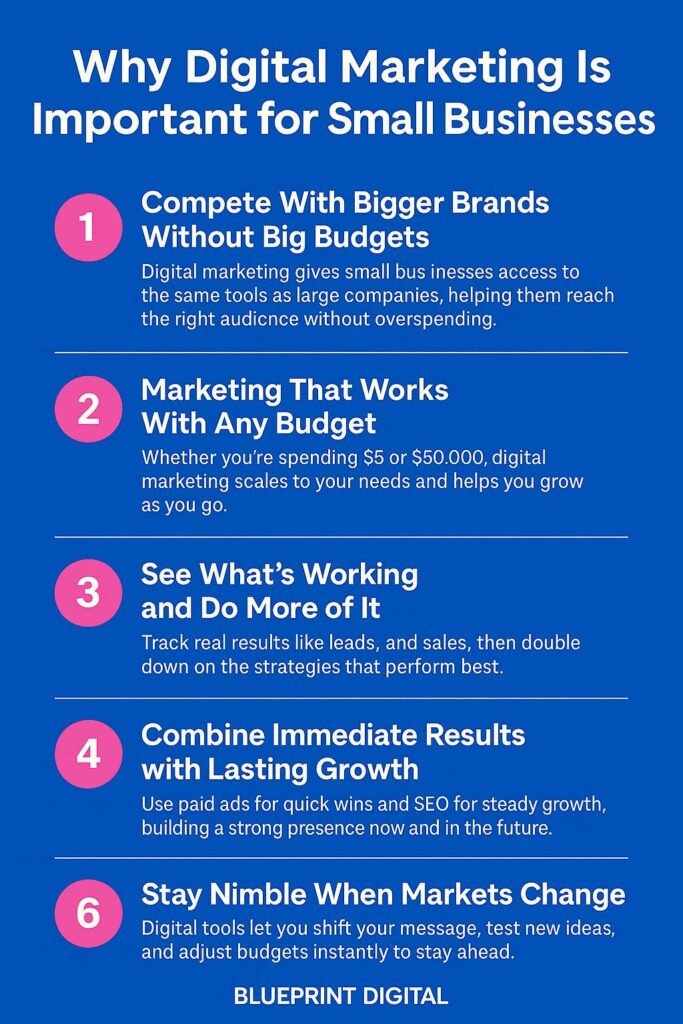 Small business owners often juggle tight budgets and big ambitions. With limited time and money, it’s easy to feel overwhelmed about where to spend your marketing dollars. The good news is that digital marketing can offer an outsized return on investment for small businesses. More than just a necessary expense, digital marketing done well is one of the smartest and most flexible investments you can make to grow your business.
Small business owners often juggle tight budgets and big ambitions. With limited time and money, it’s easy to feel overwhelmed about where to spend your marketing dollars. The good news is that digital marketing can offer an outsized return on investment for small businesses. More than just a necessary expense, digital marketing done well is one of the smartest and most flexible investments you can make to grow your business.
To bring deeper insight to this topic, we spoke with Chris Slesarchik, Director of SEO at Blueprint Digital. Chris helps businesses of all sizes grow online every day, and he knows firsthand what works and what doesn’t. His perspective, combined with industry data, reveals why digital marketing is a growth engine that empowers small businesses to compete and win.
1. Compete With Bigger Brands Without Big Budgets
“With digital marketing, you can do a whole lot with a really small budget. It gives small businesses a unique way to compete with those bigger brands without needing massive resources. You can target the exact audience you want and see what’s working in real time…that’s powerful for small businesses that don’t have time or money to waste.” – Chris Slesarchik, Director of SEO, Blueprint Digital
One of the greatest advantages of digital marketing is leveling the playing field. Online, your business has access to the same platforms and audience reach as large enterprises without needing a Fortune 500 budget. Digital channels like Google search, social media, and email are open to everyone. Platforms like Google, social media, and email are accessible to everyone, giving local companies a real shot at gaining visibility.
Importantly, digital marketing lets smaller companies reach customers without the extravagant costs of traditional media like TV or print. With savvy SEO, engaging social posts, and pay-per-click ads aimed at your niche, your brand can stay visible and relevant.
2. Marketing That Works With Any Budget
Digital marketing is scalable to any budget. Whether you have $500 or $50,000 to spend, you can craft a campaign that fits your means and still drives results. This makes it uniquely friendly to startups and local businesses. Here’s why even a small budget can go far online:
- Start small and gain traction: Platforms like Google Ads and Facebook allow you to start with minimal spend – even a few dollars a day – and ramp up as you see results. You can also leverage free tactics like setting up a Google Business Profile or engaging on social media to start building visibility at no cost. Local SEO (optimizing your website and listings for local searches) is often Chris’s first recommendation for a small budget, because it “can start to drive foot traffic and calls without a huge investment,” especially if your website is already in decent shape. In short, digital lets you get your name out there and generate leads without a big upfront investment.
- Only pay for what works: Unlike traditional marketing, digital campaigns are highly trackable and adjustable in real time. You can put a small budget into multiple tactics, test which one brings the most leads or sales, and then funnel more money into the winners. If an ad isn’t delivering, you can pause it instantly. Every click, call, or lead can be tracked, helping you avoid wasted spend and make informed decisions that move your business forward.
- Built-in smart tools (even AI): Major digital platforms come with automated features to help you maximize a tight budget. For example, Google Ads offers smart bidding strategies that use AI to adjust your bids for better conversions, so you get more results from the same spend. Facebook can auto-optimize your audience targeting if you let it, finding people likely to engage. These tools act as force multipliers for small teams.. Chris notes that AI is reshaping marketing, but it should be used “as a tool, not a crutch.” In practice, that means automation can handle tedious tasks and speed up optimizations, freeing you to focus on strategy and creative ideas that connect with customers.
In crafting a digital strategy on a shoestring, prioritization is key. Chris advises small businesses not to spread themselves too thin: “Don’t try to do everything at once. Focus on one or two channels that meet your audience where they’re at, get them working, test small, and then reinvest in what’s working and scale up from there,” he says. As those efforts start producing leads or sales, you can gradually expand your budget and tactics.
Read more: 8 Types of Digital Marketing Every Business Should Know
3. See What’s Working and Do More of It
In the past, much of marketing was a guessing game. You’d run an ad and hope the phone rings. Digital marketing changed that completely. Today, small businesses can see exactly what’s working in their marketing and make decisions based on real data. This ability to measure and optimize is perhaps the biggest reason digital marketing is such a wise investment.
Digital platforms like Google Analytics and Facebook Ads Manager offer detailed metrics. You can see who viewed, clicked, and took action on your ads. More importantly, you can track conversions like form submissions, calls, or purchases to see what’s driving results. Chris emphasizes looking beyond surface metrics like clicks or traffic: “The first thing I check is whatever the most valuable metric within our control is – almost always, conversions,” he says. For a small business, that might be form submissions, quote requests, phone calls, or purchases. Zeroing in on these meaningful actions can identify which marketing efforts are truly driving revenue.
Once you know what’s driving results, you can do more of it and fix or cut out what isn’t working. If your Google Ads campaign for “emergency plumber near me” brought in 10 calls last month but your Facebook ads didn’t convert any customers, you might shift more budget into Google and refine or pause the Facebook campaign. If one page on your website is generating a lot of leads, you might enhance it further (or drive more traffic to it), while pages that underperform can be improved or removed.
“From there, I look into whether we can double down on certain things that are working, or optimize things that are broken,” Chris explains. It’s an ongoing cycle of refinement: remove friction, boost what works, and avoid wasting money on underperforming tactics.
4. Combine Immediate Results with Lasting Growth
Digital marketing excels at quick wins and long-term growth, especially when you combine tactics like pay-per-click advertising (which can generate leads today) with strategies like SEO and content marketing (which steadily build your visibility for tomorrow). Chris often explains this balance using a real estate analogy.
“Paid search is like renting. You can move in tomorrow, but if you stop paying, you lose access. SEO is like buying a house. It takes longer to see value, but you’re building equity over time.” – Chris Slesarchik, Director of SEO, Blueprint Digital
To give an example, Chris says that a well-optimized website acts like an appreciating asset, consistently bringing in traffic and leads over time. That’s why he typically recommends a hybrid approach.
In practice, this means running paid campaigns, like Google or Facebook ads targeting “emergency dentist [Your Town]” or a limited-time offer, to generate leads right away. It’s effective when you need results fast. But as soon as you stop paying, the leads stop too. That’s why long-term digital assets matter. Optimizing your website, publishing helpful content, and improving SEO builds something that grows over time, bringing in free traffic and steady brand visibility.
Blueprint Digital Case Study: AICA Orthopedics
Chris talks about AICA Orthopedics as a standout example of how digital marketing can power strategic growth. When AICA first partnered with Blueprint, they had only a few local clinics. Today, they’ve expanded to 18 locations across the Atlanta metro area.
“Paid search and SEO gave them the ability to scale with precision as they opened new locations,” Chris explains. Each time AICA launched a new clinic, Blueprint rolled out hyper-targeted paid search campaigns in that local market to quickly attract high-intent patients. At the same time, the team built long-term visibility through localized SEO, content, and Google Business Profile optimization.
The strategy was about targeting the right patients. Using search intent data, Blueprint focused on keywords tied to AICA’s most profitable services, ensuring ad dollars went toward driving quality leads. Over time, even as ad spend tapered off, organic search traffic kept flowing thanks to the behind-the-scenes SEO work.
This combination of immediate traction and long-term visibility allowed AICA to grow responsibly, generating leads right away while compounding brand presence across each market.
Read more about AICA Orthopedic’s Case Study
5. Be Where Your Customers Are Looking
Today’s customers live online. They use search engines, maps, social networks, and review sites to find solutions to their problems, which means your business needs to show up wherever they’re looking. From a practical standpoint, this means investing in your online presence across multiple channels so you’re visible at the right moments. Consider a typical customer journey: someone might search Google for a service, compare a few websites, check the Google or Yelp reviews for each business, maybe look at a Facebook page or LinkedIn profile, and read a blog or two before making a decision. If your business is missing from any of these touchpoints, it’s likely a competitor will grab that customer’s attention instead.
Statistics underline just how digital-first buyer behavior has become. About 80% of US consumers search online for local businesses every week, and over 90% of consumers check online reviews before visiting a business. And it’s not only B2C shoppers. Business buyers also heavily research online, often conducting a dozen or more searches prior to engaging a B2B vendor.
To reach the right customers, you need to show up where they’re already spending time online. That starts with making sure your website and business listings appear in local search results and convey trust at a glance. It also means being present on the platforms your audience uses, and following up with smart, ongoing marketing so they don’t forget you. When you cover these touchpoints, you make it easier for people to choose you.
6. Stay Nimble When Markets Change
If the past few years have taught business owners anything, it’s that the market can change quickly. Consumer behaviors can shift, new competitors can emerge, and external events (like economic swings or pandemics) can upend business as usual. In such times, being able to pivot your marketing quickly is mission-critical, and this is another area where digital marketing shines.
During the COVID-19 pandemic, for example, businesses that were quick to update their websites and online ads to communicate new services (like curbside pickup, virtual consultations, or delivery options) were able to retain customers, whereas slower-moving competitors lost out. Digital marketing channels let you instantly communicate changes or new offerings to your audience. One of the strengths of digital campaigns is that if something isn’t working, you can stop it – pause that Facebook ad, turn off that email series – and try a different approach without burning through the rest of your budget.
Additionally, digital marketing fosters an experimental mindset that benefits small businesses in rapidly changing markets. You can A/B test different headlines, try targeting new niches, or experiment with emerging platforms (like a new social media trend) relatively cheaply and quickly. The data will tell you if it’s working, and you can either scale it up or switch tactics. This agility extends to budget allocation as well. If the holiday season is coming and you know customers will be searching more online, you can boost your ad spend temporarily, then dial it back after. You’re always in control, able to reallocate resources to where they make the most impact right now.
Small businesses that embrace digital marketing are essentially building a nimble marketing machine: one that can react, adapt, and seize opportunities at the speed of the internet.

Why Blueprint Digital Is Built for Businesses Like Yours
At the end of the day, digital marketing is the best investment a small business can make because it’s measurable, scalable, and aligned with how modern customers make decisions. But it’s also a lot to manage on your own, especially when you have a business to run. That’s exactly why Blueprint Digital exists.. We’re a full-service digital agency that offers SEO, PPC, paid social, web design and development, email marketing, and more, all tailored for your business goals, budget, and target audience.
Our team has experience driving growth for companies ranging from startups to Fortune 500 corporations, and we bring that expertise to every client engagement, big or small.
Ready to turn your marketing into your best growth engine? Start with a FREE strategy call today.
GET STARTED with Blueprint Digital


